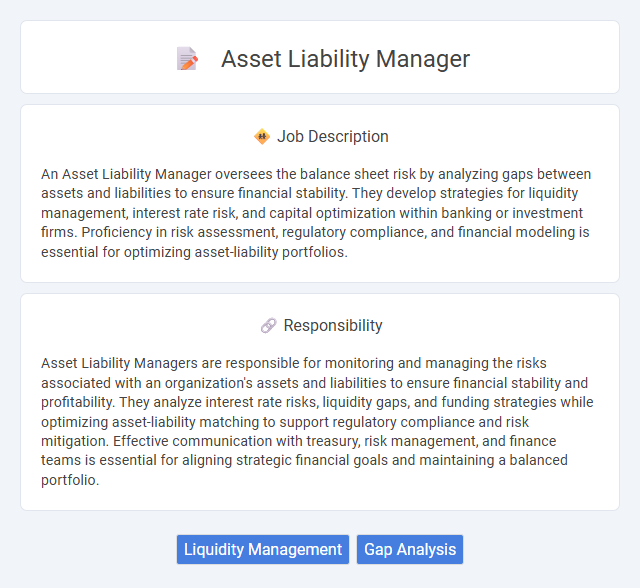
An Asset Liability Manager oversees the balance sheet risk by analyzing gaps between assets and liabilities to ensure financial stability. They develop strategies for liquidity management, interest rate risk, and capital optimization within banking or investment firms. Proficiency in risk assessment, regulatory compliance, and financial modeling is essential for optimizing asset-liability portfolios.
People with strong analytical skills and a keen attention to detail are likely to be suitable for an Asset Liability Manager role. Candidates who handle stress well and have the ability to make critical decisions under pressure may find this job aligns with their capabilities. Those lacking interest in financial markets or risk management may struggle to excel in this position.
Qualification
An Asset Liability Manager requires a strong background in finance, economics, or accounting, typically supported by a bachelor's degree in these fields. Expertise in risk management, financial modeling, and regulatory compliance is essential, along with proficiency in statistical software and financial analytics tools. Professional certifications such as CFA, FRM, or CPA enhance qualifications and demonstrate advanced knowledge in managing balance sheet risks and liquidity.
Responsibility
Asset Liability Managers are responsible for monitoring and managing the risks associated with an organization's assets and liabilities to ensure financial stability and profitability. They analyze interest rate risks, liquidity gaps, and funding strategies while optimizing asset-liability matching to support regulatory compliance and risk mitigation. Effective communication with treasury, risk management, and finance teams is essential for aligning strategic financial goals and maintaining a balanced portfolio.
Benefit
An Asset Liability Manager likely enhances an organization's financial stability by effectively balancing assets and liabilities, reducing risks associated with market fluctuations. This role probably improves liquidity management and optimizes investment returns, contributing to stronger financial performance. Companies may benefit from more accurate forecasting and strategic planning driven by expert asset-liability management.
Challenge
An Asset Liability Manager likely faces the challenge of balancing risk and return while ensuring sufficient liquidity to meet future obligations. They probably need to navigate market volatility and interest rate fluctuations, which can complicate long-term financial planning. Effective stress testing and scenario analysis might be crucial to anticipate potential mismatches between assets and liabilities.
Career Advancement
Asset liability managers optimize financial risks by analyzing interest rate and liquidity gaps, supporting institutional stability. Mastery of risk management models and regulatory compliance enhances promotion prospects within banking or insurance sectors. Advanced certifications like CFA or FRM significantly boost career growth and leadership opportunities in finance.
Key Terms
Liquidity Management
Asset liability managers specialize in liquidity management by monitoring and balancing the cash flow needs of financial institutions to ensure sufficient liquidity for operational requirements and regulatory compliance. They analyze asset and liability exposures, stress test liquidity scenarios, and implement strategies to optimize cash reserves and funding sources. Proficiency in market trends, risk assessment, and regulatory frameworks like Basel III is crucial for effective liquidity risk mitigation and maintaining financial stability.
Gap Analysis
Asset liability managers specialize in gap analysis to identify mismatches between assets and liabilities, ensuring optimal balance sheet structure. They assess interest rate risk by measuring timing differences in cash flows to mitigate exposure and maintain regulatory compliance. Effective gap analysis supports strategic decision-making to enhance financial stability and profitability.
 kuljobs.com
kuljobs.com